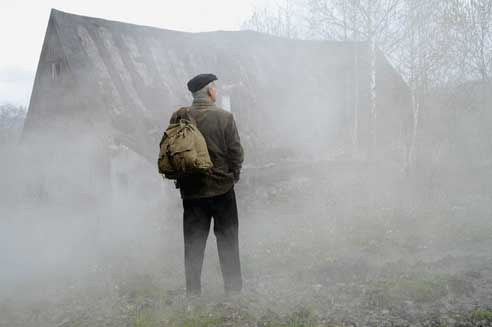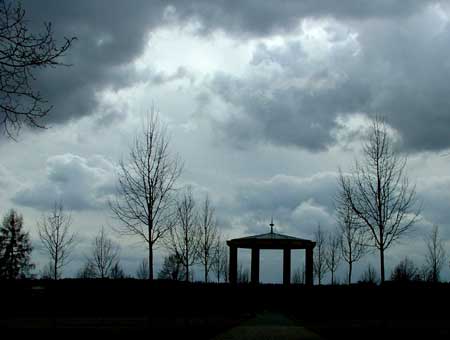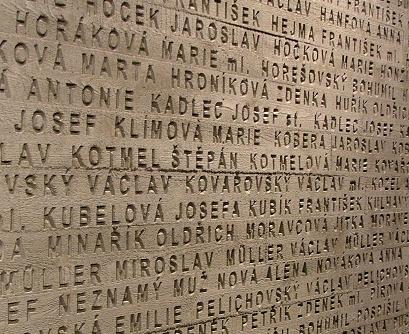Affordable travel in the Czech Republic |
Outside Prague |
| • Kutná Hora |
| • Litomyšl |
| • Olomouc |
| • Český Krumlov |
| • Karlovy Vary |
| • Mělník |
| • Kutná Hora |
| • Karlštejn castle |
| • Terezín |
| • Lidice |
| • Adršpach Rocks |
| • Bohemian Paradise |
| • České Budějovice |
| • Český Ráj |
| • Hradec Králové |
| • Liberec |
| • Plzeň |
| • Telč |
| Mikulov |
| Ostrava |

The Destruction of Lidice Lidice was a village that stood about 20 kilometres north-west of Prague until June 1942 when it was completely destroyed and erased from all maps by the occupying forces of Nazi Germany. Resistance to Nazi occupation
Perhaps their greatest success was the June 1942 assassination of Hitler's third-in-command, and most powerful figure in occupied Czechoslovakia, Reichsprotektor Reinhard Heydrich. Heydrich was ambushed by British trained Czechoslovak paratroopers while driving through Prague and died as a result of his injuries several days later. Hitler's Retaliation An enraged Hitler ordered his men to ‘wade through blood’ to find those responsible, and his orders regarding any communities found harbouring the assassins were to1. Execute all men and boys above the age of 15 2. Transport all women to a concentration camp 3. Place children suitable for Aryanization into approved families 4. Level the entire village to the ground The village of Lidice several kilometres north west of Prague was chosen for exactly that treatment, despite there being no proof that the villagers were in any way connected with Heydrich's death. Unlucky Lidice The Kladno Gestapo concluded there was no connection with the Heydrich assassination and reported that to Prague, but by then the fate of the village was sealed. The new top man in Nazi hierarchy, Karl Frank, had already decided to make an example of Lidice to demonstrate his tough approach and at Heydrich’s funeral in Berlin on the 9th of June, Hitler agreed.
 The destruction of Lidice was filmed by the Nazis and the footage later served as evidence against them in the Nuremberg trials. The footage also features heavily in the video presentation of the excellent visitors centre and museum on a low rise that overlooks the valley in which Lidice once stood. The destruction of Lidice was filmed by the Nazis and the footage later served as evidence against them in the Nuremberg trials. The footage also features heavily in the video presentation of the excellent visitors centre and museum on a low rise that overlooks the valley in which Lidice once stood.
|
 |
What, why and where? |
| • The Destruction of Lidice |
| • Lidice Museum and Memorial |
Check prices of Rooms in Prague |
| Getting there |
| • Getting to Lidice |
• Home •Blog• About• Contact• Sitemap •Links•
Outside Prague last updated June 13th, 2010. All text and images Copyright 2007-2010. Articles may be excerpted for review, or printed for use by individual travellers.
Complete articles or images may not otherwise be reproduced by print, electronic or other means.
 The Czech lands were among the first places to be occupied by the Nazi Germany in their aggressive expansion that led to the outbreak of WWII. During the years that followed there was a small but effective resistance movement that aimed to hinder the occupying Nazi forces whenever possible.
The Czech lands were among the first places to be occupied by the Nazi Germany in their aggressive expansion that led to the outbreak of WWII. During the years that followed there was a small but effective resistance movement that aimed to hinder the occupying Nazi forces whenever possible. How the SS chose Lidice remains unclear decades later, but there are several theories. One involves a love letter to a local girl intercepted by her employer and turned over to the Gestapo because it seemed the writer had some part in the assassination. Under interrogation Anna recalled that her lover had once asked her to pass on greetings to the Horák family of Lidice from their son, who was serving with the RAF in Great Britain.
How the SS chose Lidice remains unclear decades later, but there are several theories. One involves a love letter to a local girl intercepted by her employer and turned over to the Gestapo because it seemed the writer had some part in the assassination. Under interrogation Anna recalled that her lover had once asked her to pass on greetings to the Horák family of Lidice from their son, who was serving with the RAF in Great Britain. Early on the morning of the 10th, an SS Task Force surrounded Lidice and rounded up all the villagers. The woman and children were transferred to Kladno, where they were separated; The 184 women were sent by train to Ravensbruck concentration camp and the 88 children were sent to Lodz in Poland. In Poland a handful of Lidice’s children were selected for Germanization and the rest were transferred to Chelmno, where they were gassed on the day of their arrival.
Early on the morning of the 10th, an SS Task Force surrounded Lidice and rounded up all the villagers. The woman and children were transferred to Kladno, where they were separated; The 184 women were sent by train to Ravensbruck concentration camp and the 88 children were sent to Lodz in Poland. In Poland a handful of Lidice’s children were selected for Germanization and the rest were transferred to Chelmno, where they were gassed on the day of their arrival. Lidice’s men and older boys were taken to the farmhouse of the Horák family on the edge of the village, where they were lined up against the wall of the barn, and shot by firing squad, ten at a time. The dead were left where they fell and the new groups of ten were lined up without blindfolds until there were 173 dead bodies lying in the Horáks’ orchard.
Lidice’s men and older boys were taken to the farmhouse of the Horák family on the edge of the village, where they were lined up against the wall of the barn, and shot by firing squad, ten at a time. The dead were left where they fell and the new groups of ten were lined up without blindfolds until there were 173 dead bodies lying in the Horáks’ orchard.